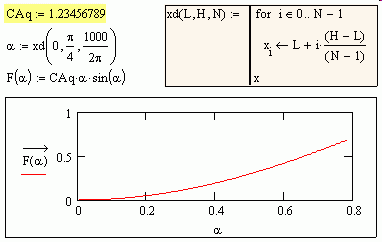- Subscribe to RSS Feed
- Mark Topic as New
- Mark Topic as Read
- Float this Topic for Current User
- Bookmark
- Subscribe
- Mute
- Printer Friendly Page
Newbie question......I put in degree units and the thing breaks
- Mark as New
- Bookmark
- Subscribe
- Mute
- Subscribe to RSS Feed
- Permalink
- Notify Moderator
Newbie question......I put in degree units and the thing breaks
Hi,
I don't use Mathcad all that much anymore so I am no longer very skilled at it. This is also my first post to this forum.
I defined a range variable with no units and then used it to compute some normal force numbers. I then put in the unit simple in the range variable for degrees and the thin stopped working int the force formula. Can anyone shed some light on this one for me? I have attached images of the area of the sheet that is giving me grief. I can just do it all in radians and it works fine.......just figured I would see what I am missing here.
- Labels:
-
Physics
- Mark as New
- Bookmark
- Subscribe
- Mute
- Subscribe to RSS Feed
- Permalink
- Notify Moderator
Hi William,
You have raised an expression involving units to a power involving a range variable or a vector. As a result, there is no way to determine the dimensions of the result. If an expression is defined with units, you can raise it only to a fixed real power.
Hope this can help.
/K
- Mark as New
- Bookmark
- Subscribe
- Mute
- Subscribe to RSS Feed
- Permalink
- Notify Moderator
I think you read it wrong but thanks.
- Mark as New
- Bookmark
- Subscribe
- Mute
- Subscribe to RSS Feed
- Permalink
- Notify Moderator
If you define a range variable with units you need to include the second term. Try a:=0*deg,1*deg...45*deg
- Mark as New
- Bookmark
- Subscribe
- Mute
- Subscribe to RSS Feed
- Permalink
- Notify Moderator
Thanks. That did the trick.
- Mark as New
- Bookmark
- Subscribe
- Mute
- Subscribe to RSS Feed
- Permalink
- Notify Moderator
You could use define a vector instead of using a range variable.
See attached image.
Mike
- Mark as New
- Bookmark
- Subscribe
- Mute
- Subscribe to RSS Feed
- Permalink
- Notify Moderator
Whether the argument to sin(x) is default radian or °, the result is a number or a range of numbers, dimensionless numbers ... as well as x*sin(x). If you put units ° , you just have to scale it again vs the default radian, but still dimensionless numbers [a range of numbers], in other words a dimensionless scaling function. Assume you do that part right and get the desired function, you are left with A [unit of something] and q [unit of something]. Their product are now in the corresponding unit system of the measured or entered A, q. The coefficient C is dimensionless , therefore you only need to put units in A & q. What you don't say is what alpha represents [ orientation, elevation or else]. The fact that you are using or borrowing a trig function is immaterial, it could be a piece of polynomial or any suitable model having same alpha argument.

jmG


